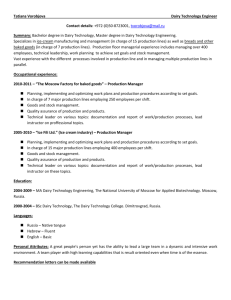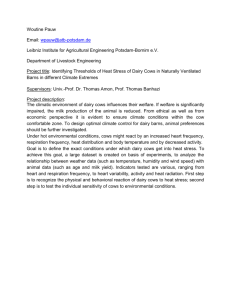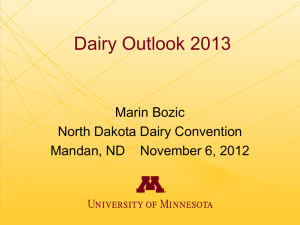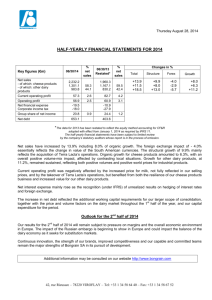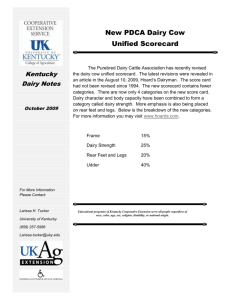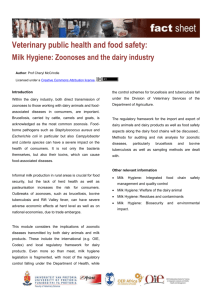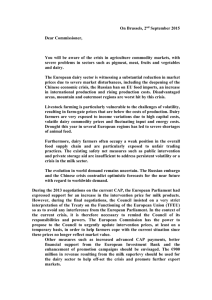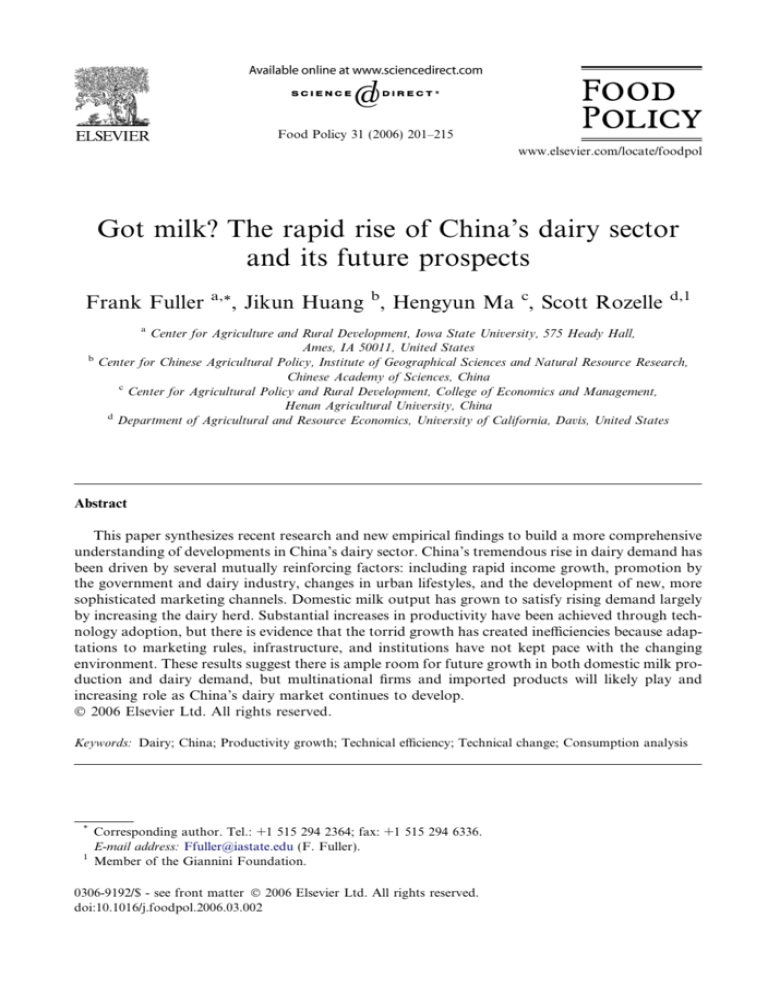
Food Policy 31 (2006) 201–215
www.elsevier.com/locate/foodpol
Got milk? The rapid rise of China’s dairy sector
and its future prospects
Frank Fuller
a,*
, Jikun Huang b, Hengyun Ma c, Scott Rozelle
d,1
a
b
Center for Agriculture and Rural Development, Iowa State University, 575 Heady Hall,
Ames, IA 50011, United States
Center for Chinese Agricultural Policy, Institute of Geographical Sciences and Natural Resource Research,
Chinese Academy of Sciences, China
c
Center for Agricultural Policy and Rural Development, College of Economics and Management,
Henan Agricultural University, China
d
Department of Agricultural and Resource Economics, University of California, Davis, United States
Abstract
This paper synthesizes recent research and new empirical findings to build a more comprehensive
understanding of developments in China’s dairy sector. China’s tremendous rise in dairy demand has
been driven by several mutually reinforcing factors: including rapid income growth, promotion by
the government and dairy industry, changes in urban lifestyles, and the development of new, more
sophisticated marketing channels. Domestic milk output has grown to satisfy rising demand largely
by increasing the dairy herd. Substantial increases in productivity have been achieved through technology adoption, but there is evidence that the torrid growth has created inefficiencies because adaptations to marketing rules, infrastructure, and institutions have not kept pace with the changing
environment. These results suggest there is ample room for future growth in both domestic milk production and dairy demand, but multinational firms and imported products will likely play and
increasing role as China’s dairy market continues to develop.
Ó 2006 Elsevier Ltd. All rights reserved.
Keywords: Dairy; China; Productivity growth; Technical efficiency; Technical change; Consumption analysis
*
1
Corresponding author. Tel.: +1 515 294 2364; fax: +1 515 294 6336.
E-mail address: Ffuller@iastate.edu (F. Fuller).
Member of the Giannini Foundation.
0306-9192/$ - see front matter Ó 2006 Elsevier Ltd. All rights reserved.
doi:10.1016/j.foodpol.2006.03.002
202
F. Fuller et al. / Food Policy 31 (2006) 201–215
Introduction
In the 1990s, during the second decade after China’s emergence from its period of
Socialist isolation, Garnaut and Ma (1993) noted that the nation’s food consumption patterns were emerging in ways that were largely consistent with other East Asian nations –
with one notable exception. Given China’s income level, the demand for grain, most meat
commodities, aquaculture products, fruits and vegetables were at or exceeded the expected
levels of consumption. There was only one major commodity that China’s consumers were
under consuming: dairy. The average urban resident in 1992 only consumed a milk equivalent of 9.07 kg per capita of dairy products, only a fraction of level in many other
nations.2 While Garnaut and Ma (1993) postulated that ‘‘different tastes associated with
historical contact with international consumption patterns’’ was the cause for the unusually low consumption of milk in China, we suggest below that historical preferences are
only one of the factors influencing dairy demand.
Since the mid-1990s the lethargy of China’s dairy sector has disappeared and a large
literature has appeared trying to understand it. Demand, especially in urban areas, has
exploded (Zhou et al., 2002). Dairy production has risen sharply. Internationally there
is a scramble to understand the implications China’s emerging dairy sector for world
trade. While many papers have appeared recently that address the supply and demand
for dairy products in China (Zhou et al., 2002; Fuller et al., 2004a,b), we believe that
the literature still lacks research that systematically explains the recent emergence of
China’s dairy industry and its future demand and supply trends.
This paper sketches a more comprehensive picture of China’s dairy sector and
assesses the nature of the sector’s development in the coming decades. In the first
two sections, we draw upon the growing number of empirical studies to identify
the factors underlying the explosion in China’s dairy consumption and analyze milk
supply by assessing the relative importance of herd expansion and improvements in
efficiency to the overall growth of milk output. Based our analysis of both supply
and demand, we conclude with our perspective on the future path of dairy supply,
demand and trade in China.
Dairy demand
Urban consumers in China have greatly altered their diets in the last 20 years, increasing the share of calories derived from animal fats and proteins, decreasing their intake of
carbohydrates from grains, and increasing consumption of sugar and vegetable oils (Hsu
et al., 2001; Guo et al., 2000). Despite rapid income growth throughout the late 1980s and
early 1990s, fluid milk consumption in urban areas remained strangely stagnant from 1987
2
Fluid milk equivalent of fluid milk consumption reported in the CNBS Urban Household Income and
Expenditure Survey and total dairy consumption data reported in Zhou (2001). Total dairy consumption of
6.32 kg contains 5.52 kg of fluid milk and an estimated 0.43 kg milk powder and 0.37 kg yogurt. Milk powder is
converted at a rate of 7.4:1 to fluid milk and yogurt is converted at a rate of 1:1. Rural per capita consumption is
estimated by subtracting urban consumption from total milk production. Zhou (2001) cites an average of 1.46 kg
of dairy products for rural residents in 1992, which is equivalent to 1.25 kg of fluid products and 0.21 kg of milk
powder.
F. Fuller et al. / Food Policy 31 (2006) 201–215
203
Table 1
Annual urban dairy product consumption (kg per person) per capita by income group
1996
1997
1998
1999
2000
2001
2002
2003
Fresh products
Lowest 10%
Third Quintile
Top 10%
Average
2.52
4.84
7.91
4.83
2.62
4.97
9.02
5.07
2.87
6.17
10.66
6.18
3.34
7.62
13.78
7.88
4.59
9.83
17.52
9.94
5.61
11.78
19.60
11.90
4.83
15.79
26.46
15.72
6.71
18.94
28.29
18.62
Yogurt
Lowest 10%
Third Quintile
Top 10%
Average
0.11
0.33
0.56
0.32
0.15
0.44
0.78
0.44
0.28
0.57
1.16
0.64
0.39
0.80
1.47
0.87
0.51
1.09
1.47
1.12
0.55
1.30
2.27
1.36
0.51
1.76
3.31
1.80
0.68
2.57
4.33
2.53
Milk powder
Lowest 10%
Third Quintile
Top 10%
Average
0.22
0.42
0.59
0.41
0.23
0.40
0.61
0.41
0.24
0.43
0.6
0.43
0.25
0.47
0.62
0.44
0.26
0.52
0.7
0.49
0.29
0.52
0.74
0.50
0.34
0.58
0.65
0.60
0.31
0.61
0.63
0.56
Average total
8.18
8.54
10.00
12.00
14.67
16.96
21.96
25.29
Source: CNBS. Milk powder converted to milk equivalent at a rate of 7.4:1.
to 1997 at an average of 4.81 kg per person.3 Since 1998, however, fluid milk consumption
in urban China has grown annually at double digit rates.
According to data from official sources, Table 1 shows that dairy product consumption
has increased at all income levels for the three product categories reported. On average,
urban milk demand in China was roughly half of the level in Taiwan in 2003. Even households in the lowest 10% of the income distribution more than doubled their milk consumption in 7 years. Fresh product (primarily fluid milk) consumption increased nearly 300% or
more for higher income groups. Although yogurt consumption was lower than milk powder consumption in 1996, yogurt purchases grew roughly 29–37% annually, while milk
powder consumption grew less than 7% annually. The growth rate for milk powder consumption decreased from low income to high, and milk powder consumption per capita
for the highest income group grew just 6.7% over the entire 7-year period and actually
declined in 2002 and 2003.
The growth in household incomes has played a major role in the rapid increase in dairy
product consumption, but it cannot fully explain the changes that have occurred. The
growth in dairy product consumption only loosely corresponds to growth in real incomes.
While increases in real income generally match the pattern of dairy product consumption
growth across incomes groups (i.e., larger changes in income generate greater growth in
consumption), the increases in consumption for the lower income groups are much bigger
than one would expect, even from a luxury food item.
Several recent studies using cross-sectional household data have attempted to estimate
price and income elasticities for dairy products. One of the most striking observations is
that all of the studies suggest that milk and other dairy products are not elastic with
respect to total household income (Fuller et al., 2004a; Wang et al., 2004; Liu and Chern,
3
Fluid milk consumption does not include the milk equivalent of other dairy product consumption.
204
F. Fuller et al. / Food Policy 31 (2006) 201–215
2003). However, with respect to the household’s allocation of food expenditures, dairy
products typically represent one of the most elastic categories in the food basket (Liu
and Chern, 2003; Gould and Dong, 2004). The income elasticity estimates in the studies
were computed using data for single year, so the impacts of shifts in preferences over time
on income elasticities are not captured.
Using panel data, Guo et al. (2000) found evidence that income elasticities in urban
China changed from year to year, with elasticities for livestock products increasing and
elasticities for grains decreasing. Similarly, Huang and Bouis (2001) found empirical support for the idea that dietary changes in Taiwan in the 1980s were driven by changing
lifestyles, occupations and marketing systems, as well as price and income factors. Without doubt, the rapid growth in household incomes has been necessary to make dairy
products affordable for Chinese households, but the development of China’s economy
and the opening of society to the West over the last two decades have prompted several
other transformations that facilitated growth in dairy product consumption. Although
we are not able to precisely quantify the source of demand change, we believe the current literature and our observations in the field show that there are at least three important drivers for changes in urban dairy consumption: changes in (a) consumer
perceptions of dairy products; (b) food purchasing behavior; and (c) dairy product
marketing.
Historically, the majority of Chinese viewed milk as a nutrition supplement, particularly for infants and the elderly (Zhou et al., 2002), but it was not perceived as a food
for regular consumption by the general populous. These traditional perceptions are
being challenged on several fronts. Current government guidelines for food and nutrition include regular milk consumption in its dietary recommendations. In a survey conducted in 2001, Fuller et al. (2004b) found that more than 25% of sample households
in Beijing, Shanghai, and Guangzhou reported that a healthcare professional had recommended regular milk consumption. The expansion of television ownership has
greatly increased the influence of the mass media and advertising on consumer perceptions. Advertisements extolling the convenience, good taste, and healthiness of regular
milk and yogurt consumption have become commonplace on China’s networks. In the
same survey 93% of the sample reported seeing television advertisements for milk products, and 73% had seen billboards with dairy ads. Finally, the adoption of school milk
programs in several large cities sends the message to families with young children that
milk consumption is important for the health of China’s youth. In short, inasmuch as
the growing awareness of dairy products fosters a culture of dairy consumption, we
can expect a growing percentage of households in China to integrate dairy products
into their daily diets.
Economic prosperity in China also is gradually changing lifestyles among urban
households, and this, in turn, is affecting purchasing behaviors. Social policies to slow
population growth have reduced the number of children in modern urban families.
With greater opportunities to find employment outside the home, the cost of spending
time shopping and preparing food has risen, and an increasing number of China’s
households are willing to pay for prepared foods and packaging that increases shelf life
and reduces shopping frequency. Young, educated, and wealthy consumers shop less
frequently, eat outside the home more often, and frequently purchase processed and
packaged foods (Veeck and Veeck, 2000). Most dairy products require refrigeration
until they are consumed, and greater refrigerator ownership is having a positive impact
F. Fuller et al. / Food Policy 31 (2006) 201–215
205
on dairy product consumption (Lyon and Durham, 1999). There is also some evidence
that shoppers with higher education levels tend to buy dairy products more frequently
at supermarkets and purchase more ultra-high temperature pasteurized (UHT) milk
(Fuller and Hu, 2005).
Studies of purchasing behaviors are interesting because they highlight the connection
between income, education, product choices, and the variety of retail outlets in which China’s consumers are shopping. These relationships are closely tied to the changes that can
be observed in marketing of dairy products. Throughout the 1980s and into the 1990s, pasteurized milk was principally marketed through home distribution networks and specialized milk stores operated by the dominant local milk company (usually a state-owned
processor). This situation began to change in the early 1990s, as foreign dairy processors
began investing in production facilities near key cities and as UHT technology was
adopted by dairy processors. Both of these developments prompted the introduction of
new brands and products in urban dairy markets, sharpening the competition faced by
incumbent firms.
New entrants into local dairy markets could not use the established distribution networks because they were owned and operated by the local dairy company. Consequently,
entering firms channeled their products to consumers through other food retail outlets:
street vendors, small grocery stores, and the newly emerging supermarkets and convenience stores. While home delivery networks still play an important role in pasteurized
milk markets, surveys indicate that supermarket sales account for the majority of yogurt
and UHT milk sales and a growing proportion of pasteurized milk sales (Fuller et al.,
2004a; Fuller and Hu, 2005). Consumers benefit from the expanded selection of products
and brands available at supermarkets and from the frequent promotional discounts (Fuller and Hu, 2005).
Also important has been the creation of nationally recognized brands. When China’s
dairy products markets were local and segregated, branding was not important because
only one or two companies existed in the market. Farmers or small processors that sold
their products directly to consumers could develop a relationship with their customers,
and the relationship substituted for brand identification. As dairy companies expanded
beyond their historical marketing regions into new markets, they needed to differentiate
themselves from the local milk companies and to provide assurances of product quality
and safety to consumers in the new markets. Unreliable quality and food safety concerns
deterred some of China’s consumers from purchasing milk in the past. Marketing through
supermarkets and convenience store chains can reinforce brand equity to the extent that
consumers believe supermarkets choose the brands they carry based on product quality
and value.
In sum, the recent growth of dairy product consumption in China is driven by the convergence of several, mutually reinforcing factors. Rising incomes have prompted a shift in
consumer preferences towards meat, vegetable oils, fruits, and dairy products. Information regarding the benefits of regular dairy product consumption provided by the government, the healthcare sector, and the dairy industry is convincing a growing number of
China’s consumers to integrate dairy products into their daily diets. At the same time,
the hectic pace of the modern urban life promotes the consumption of prepared and packaged foods, including dairy products. Competition in China’s dairy industry has forced
dairy processors to adapt to the changing consumer environment by developing high-quality, branded dairy products that are made available to consumers in a wide array of retail
206
F. Fuller et al. / Food Policy 31 (2006) 201–215
outlets, including supermarkets and convenience stores. The development of nationally
recognized brands and ubiquitous use of mass media advertising reduces the search cost
for new consumers interested in adopting regular dairy consumption.
How will dairy product demand in China develop in the future? Consumption will
likely continue to rise rapidly for a number of years, but much of the growth in milk
and yogurt consumption in urban areas will come from the low and middle income segments of the population. As incomes continue to rise, consumption levels for these consumers should approach those of consumers in higher income brackets. High income
urban consumers are rapidly approaching consumption levels for milk and yogurt that
are comparable to other medium and high income Asian countries. Consequently, growth
of milk demand in these consumer segments will likely slow. At the same, there is still
room for those in the highest income categories to expand total dairy product consumption. For example, wealthy households in China consume much less cheese than consumers in Japan, Taiwan, or Korea; from this perspective, cheese demand still has substantial
growth potential. Cheese consumption in China occurs chiefly through consumption of
western-style foods in restaurants (Fuller et al., 2004a), and further development of cheese
consumption will likely follow the sales trends of pizza and other cheese-intensive restaurant foods.
In smaller cities and rural areas, many of the same factors that contributed to the
explosion of dairy consumption in large urban areas are relevant. School milk programs are being promoted in a greater number of regions each year. While the dairy
revolution has not even begun or is just beginning for many demographic groups,
consumers’ diets in small cities and in rural areas are expected to shift toward greater
consumption of livestock products as incomes rise (Huang and Bouis, 2001). Supermarkets and convenience stores are gradually moving from large to medium and small
cities (Reardon et al., 2004). When these retail venues arrive, among other things,
they bring with them the national dairy product brands, making quality dairy products accessible. The commercialization of the media as well as rising refrigerator and
television ownership are giving households the ability and incentive to increase dairy
consumption.
Finally, continued rural to urban migration will put upward pressure on the demand
for all livestock commodities, including dairy. Although one of the greatest factors limiting growth of dairy product demand in China in the future will be income levels, as rural
households begin to move into urban areas, dairy consumption will summarily rise. Even
when their income is held constant, Huang and Bouis (2001) and Huang and Rozelle
(1998) have shown that the newly arriving migrants begin to adopt the consumption patterns of their urban counterparts, including dairy demand.
Recent projections of China’s dairy product consumption reported by Dong (2006) are
generally consistent with these expectations of future growth. Assuming 7.0% annual
growth in real per capita expenditures in urban China, Dong (2006) projects average
urban fluid milk consumption will reach 32.04 kg per person in 2014, an annual rise of
5.1%. Total dairy product demand in China is anticipated to grow by 50% in milk equivalent terms. Meeting the additional demand projected by Dong (2006) with domestic milk
would require production in China to increase 11.2 million metric tons over the 2003 level.
In the next section, we seek to understand the dynamics of how producers have been able
to satisfy rising consumption in the past and how well China’s dairy sector is positioned to
meet the expected rise in demand.
F. Fuller et al. / Food Policy 31 (2006) 201–215
207
Producing dairy products in China
China’s dairy production was only about 1 million tons per year in 1980. During the following 15 years, output increased steadily by about 14% annually. However, because China
was starting from such a low base, total dairy production was only 6–7 million tons by the
mid-1990s, a level that placed China about 20th in overall milk production internationally.
After the mid-1990s, however, there was structural break (Fig. 1). Between 1997 and 2003,
the growth of dairy production accelerated to nearly 20% annually. Aggregate production
rose to more than 18 million tons in 2003, a level that ranked China 7th in the world.
Expanding production, expanding herd size
Milk production is implicitly the product of the number of dairy cows and the productivity per cow, so growth in milk production is the result of changes in these two components. By far, the most prominent source of growth of milk production in China has been
the expansion the dairy herd. In 1980, there were only about 640,000 dairy cows in China.
Between 1980 and 2000, China’s dairy cow herd grew at a rate of about 11% annually, just
under that of milk production. By 2000, there were 4.88 million dairy cows in China. China’s dairy cow herd also increased 20% annually after 2000, matching the growth of milk
production. By 2004, there were 8.93 million dairy cows in China.
Productivity gains: technology and/or efficiencies or not?
Productivity per cow is the second component of milk production. The analysis and
data required to study the productivity of China’s dairy sector, however, is not trivial,
2000
1800
1600
1400
1200
1000
Thousands of tons
800
600
400
10,000 Cows
200
Dairy products output
2003
2001
1999
1997
1995
1993
1991
1989
1987
1985
1983
1981
1979
1969
1949
0
Number of milk cattle
Fig. 1. The growth of China’s milk sector, 1949–2003. Data sources: Wang (2002) for data before 2003 and
CNBS for 2003 and 2004.
208
F. Fuller et al. / Food Policy 31 (2006) 201–215
Table 2
Milk yield, output per man-day of labor and production costs in China, 1992–2003
Year
Milk output of per labor man-day (kg)
Cost (Yuan/ton)
Specialized household dairy farms
1992
4335
1993
4234
1994
5159
1995
4998
1996
4705
1997
5071
1998
4602
1999
4421
2000
5032
2001
5121
2002
5226
2003
5342
1992–97
4750
1998–03
4957
Yield (kg/cow)
42.2
32.4
48.5
41.1
64.9
60.4
65.7
67.1
64.4
78.4
68.4
88.4
48.3
72.1
680
837
924
1236
1292
1559
1304
1261
1186
1244
1349
1329
1103
1280
State and collective dairy farms
1992
4744
1993
4736
1994
4477
1995
4757
1996
5139
1997
5155
1998
5435
1999
5889
2000
6019
2001
6000
2002
6032
2003
6091
1992–97
4835
1998–03
5911
35.9
49.0
47.8
60.9
55.1
63.8
86.9
89.9
92.9
93.5
93.7
97.6
52.1
92.4
844
983
1348
1726
1917
1816
1718
1619
1674
1671
1665
1774
1452
1687
Data source: National Agricultural Production Cost and Return Survey.
Note: Total revenue is equal to total milk output multiplied by the farm gate sale price. All value terms are
calculated at present price.
and relying on standard indicators can create an ambiguous picture. The sector is dynamic
and constantly changing. Milk production technology is extremely heterogeneous, ranging
from farmers in remote, mountainous villages with one or two dairy cows to state-of-theart dairy operations with hundreds of cows. New technologies and high quality genetics
are increasingly available, but it is unclear to what extent China’s small farmers have been
able and willing to use them. Complicating matters further, the China National Bureau of
Statistics does not collect information on many key statistics that are critical to understanding some of the sector’s most fundamental elements.
Based on information available to the authors, the partial productivity and cost data
shown in Table 2 also fail to provide clear results.4 Milk output per cow in both the spe-
4
The cost data are collected by the Price Bureau and the National Economic Development Commission and
were provided to the authors for use in this paper. Available upon request to the authors.
F. Fuller et al. / Food Policy 31 (2006) 201–215
209
cialized household and commercial/collective/state-owned farm sectors rose. Although
low by international standards, milk yields for specialized dairy households rose steadily
during the 1990s and are above the national average of roughly 2600 kg/cow. Output per
man-day also has risen, partly due to rising yields and partly to a reduction in annual mandays/cow. At the same time, the total cost per ton of milk has risen. Hence, until a multivariate analysis is performed, it is unclear whether productivity has increased. Moreover,
even if we could ascertain that productivity growth has occurred, it is important to understand whether the growth was generated by adoption of new technologies or increased efficiency in the use of current technologies. The answer to that question has bearing on
expectations of potential for future growth.
Potential for gains from technical change
There is little doubt that China’s dairy technology has improved since the pre-reform
era. Before 1980 there were almost no genetically improved dairy cows, and most of the
dairy cows were owned and managed by state farms and collectives that used extremely
labor intensive methods and poor quality rations. Feed mixes rarely included any concentrates, vitamins or other supplements.
Since 1980 improved genetic material, feeding regimes, and milking and handling
equipment have become available, partly as a result of several large and sustained government-to-government development aid efforts. More recently China’s government has
relaxed restrictions on the import of dairy technology, and greater numbers of private
and quasi-private enterprises are introducing new genetics and feeding technologies. Since
1995 the number of imported breeding cows and amount of bull semen have risen sharply
(China Customs Statistics Yearbook, 2003). With such an effort, it is likely that productivity should have increased due to technological change.
However, an industry that is characterized by hundreds of thousands of small producers, there are many possible barriers to the adoption of new technologies. For example,
credit constraints arising from a banking system that is unfriendly to producers could prevent farmers from investing in new technologies (Findlay et al., 2003). The lack of either a
strong extension or viable cooperative system hinders the spread of new technologies,
especially among a poorly educated farm population.
Changes in efficiency
Possession of advanced technology does not imply efficient production. Efficiencies can
be achieved through specialization along lines of comparative advantage or through
exploitation of scale economies. However, these gains can be offset by market and information inefficiencies associated with a swiftly changing market environment and institutions that struggle to adjust. There is anecdotal evidence that China’s dairy sector may
be experiencing both efficiency gains and losses.
Specialization and concentration of dairy production
National production data are clear that the rise of milk production from 1996 to 2003
has not occurred evenly across China. In fact, the data show a tendency for production to
specialize in two dimensions. First, the bulk of the rise in milk production during this
210
F. Fuller et al. / Food Policy 31 (2006) 201–215
period took place in North China (including all provinces that are north of the Yangtze
River). Second, within north China, there has been substantial geographic concentration
of dairy cows at the provincial level in Xinjiang and in the dairy belt that runs from Heilongjiang and eastern Inner Mongolia in the north to Hebei and Shandong on the North
China Plain. Xinjiang and the four emerging dairy belt provinces fully account for 70% of
the rise in China’s dairy herd.
Scale effects
Even through the mid-1990s the scale of the average Chinese dairy producer was extremely small. According to the 1997 census of agriculture, more than three-quarters of the
dairy herd was owned by individual farmers; the average dairy farmer in 1996 owned only
3 cows (Zhou et al., 2002). At that time a commercial dairy sector was emerging, but in
many cases the firms were state- or collective-owned. Given the lack of systematic data,
it is difficult to gauge what has happened to the average dairy herd size since the
mid-1990s, but some evidence suggests there has been little change. Small-scale household
production in other livestock sectors thrived in the late 1990s, as improvements in transportation infrastructure lowered the costs of moving feedstuffs into and products out of
poorer inland areas (Chen, 2002). In addition, many regionally supported dairy programs
established in recent years use small bank loans to help farmers that are new to the dairy
industry purchase one to three dairy cows. A survey conducted in 2000 by the Center for
Chinese Agricultural Policy found that sample households raising dairy cows owned an
average of four cows, a level that was statistically indistinguishable from the three cows
per household found in the 1997 census.
Despite the apparent small scale of production, there are strong incentives for processing firms to promote larger scale dairies that make effective use of technologies which
increase the quality of the milk and reduce costs. Indeed, there is some evidence that
the commercial sector may be expanding and that a healthy ‘‘specialized household’’ sector is increasing its share of the national herd (Wang, 2002). More importantly, dairy processors are playing a strategic role in developing unique institutional structures in some
regions to capture scale economies with household production. For example, in Inner
Mongolia we observed several processor-run milking stations where farmers can bring
their cows to be milked using the processor’s milking machine. The milk goes directly into
the processor’s bulk cooling tank, and farmers receive the market price. In Yunnan and
Sichuan, farmers can buy or rent stalls in a commercial milking shed, where they house
and milk their cows. The farmer is responsible for feeding and providing care for the
cow, while the milking shed manager keeps the milking and cooling equipment operating
and coordinates deliveries and payments with the processors. It is unclear how common
such arrangements are; nevertheless, their existence demonstrates the importance that processors place on increasing the scale and sophistication of milk production.
Disequilibria from expansion and institutional change
While increasing concentration and scale expansion may be generating efficiency gains,
it is certainly possible that the torrid pace of development in the dairy industry is creating
so much change and disequilibria that measured efficiency (at least temporarily) is falling
on aggregate. With the herd size growing by 20% per year, the number of cows in China
F. Fuller et al. / Food Policy 31 (2006) 201–215
211
doubles every four years. New producers are entering. Experienced producers are changing their genetics and upgrading their milking facilities. Commercial operations are changing management incentive plans and control-rights regimes, and they are altering the way
they interact with small producers, processors, and local governments. It is well recognized
in the economics literature that high adjustment costs often leads to inefficiencies as firms
and whole industries make new investments.
Our observations in production areas reveal that there may be inefficiencies related to
industry growth, especially in the ways that processors interact with producers during periods of supply expansion in a locality. According to one major Shanghai dairy processor,
more processing plant capacity has been built in China during the past 5 years than during
the entire history of milk production in China. Successfully establishing a new plant
requires the processor to develop reliable links with raw milk suppliers and to provide a
set of production, collection, and pricing rules. However, industry participants make it
clear that establishing raw milk supplies for a new processing plant entails more than simply providing an orderly marketing structure for farmers. In many locations the construction of a new processing plant has sparked a series of local dairy wars. As soon as a new
plant becomes operational, there is immediate pressure to operate at full capacity to
reduce average costs. In most cases, the new plants are unwilling to invest the time and
effort to fully develop their raw milk supply base from scratch. Instead, they often opt,
at least in part, to induce producers in the area to switch from their current buyer to
the new processing firm. Even when milk producers are bound by a written contract to
supply a particular processor (which is rare), processors have few legal remedies to prevent
another firm from poaching its raw milk supplies. We have encountered producers that
have switched buyers every several months for a period of years. This confusion and
uncertainty can prompt temporary declines in the industry’s efficiency.
An empirical analysis of productivity, technical change and efficiency shifts
It is clear from the discussion above that a large share of the rise of China’s dairy production can be attributed to the increase in the dairy herd; however, empirical evidence is
lacking concerning the direction, magnitude, and source of any changes in productivity. In
this section, we briefly present results from estimation of a stochastic production frontier
for China’s dairy sector. The model provides estimates of total factor productivity (TFP)
growth from 1991 to 2001 for a panel data set. We decompose the estimated productivity
growth into components resulting from technical change and from shifts in productive efficiency. The methods, data and empirical approach used for this analysis are discussed in
detail in Rae et al. (2005).
Results
Due to the unbalanced nature of our panel data, some clarification of the procedures
used in constructing the results reported in Table 3 is required. First, while average productivity growth rates are presented for the entire 1991–2001 period, there are insufficient
degrees of freedom to allow us to present results for the early 1990s and the 2000–2001
period. Second, individual provincial results are included in growth rate calculations, provided that at least six provincial observations were available within the relevant time period. Third, provincial results are averaged to the regional level using output shares as
212
F. Fuller et al. / Food Policy 31 (2006) 201–215
Table 3
Annual growth (%) in milk total factor productivity (TFP) and decomposition into technical efficiency (TE) and
technical change (TC)
Regiona
1990s
North
Central
South
Southwest
West
Mean
Specialized households
Commercial operations
Output
TFP
TE
TC
Output
4.75
14.82
4.55
n.a.
11.48
8.81
2.87
0.02
8.93
n.a.
2.50
0.48
5.25
7.31
7.99
n.a.
6.45
6.09
8.13
7.33
16.92
n.a.
3.95
6.58
2.84
12.18
1.99
2.73
10.47
5.25
TFP
0.60
0.87
6.37
9.05
1.15
1.31
TE
5.60
6.99
0.58
8.83
0.35
3.26
TC
5.01
6.12
6.96
17.88
1.50
4.57
For commercial operations: North: Beijing, Tianjin, Mongolia, Liaoning and Jilin; Central: Hebei, Shandong,
Henan and Hubei; South: Shanghai, Jiangsu, Anhui, Fujian, Hunan, Guangdong; Southwest: Guangxi and
Chongqing; West: Shaanxi, Gansu and Xinjiang.
In total, these provinces accounted for 59% and 57% of specialized household and commercial farm output in
1999–2001.
n.a. = Data unavailable.
a
For specialized households: North: Tianjin, Mongolia, Liaoning, Jilin and Heilongjiang; Central: Hebei,
Shandong and Henan; South: Anhui and Fujian; West: Shaanxi and Xinjiang.
weights. Finally, overall average productivity results are obtained by averaging the outputweighted regional results.5
Milk production over the 1990s on specialized and commercial farms grew annually
around 9% and 5%, respectively. Hence, compared with the overall production rates of
growth reported in official statistics for the entire 1990 to 2001 period, the rates in Table
3 are somewhat lower. Adjustments made to output levels in preparing the data preparation for analysis are partially responsible for the difference; however, it may also indicate
that small-scale producers have contributed more to output growth than specialized
households and commercial operators.
Rising TFP accounts for only a portion of the robust output growth. Just 0.48% of
growth in the specialized household sector and 1.31% of growth in the commercial sector
stems from rising TFP. Thus, input augmentation – heifer purchases, feed concentrates,
equipment, and other inputs – generates much of the output growth. Compared to a similar decomposition of China’s other livestock sectors reported in Rae et al. (2005), TFP’s
contribution to output growth is lower for milk production than all other livestock sectors,
except backyard hog production.
Interestingly, while TFP growth for dairy was low compared to other livestock sectors,
the contribution of technology is among the highest. Overall, technical change (TC) generated a 6.58% annually increase in productivity in the specialized household sector and
4.57% increase in the commercial sector. Indeed, most of the productivity growth in the
specialized and commercial dairy sectors appears to be the result of adopting improved
genetics, better milking processes, and superior management practices. Following this
5
In the TFP decompositions we do not present the scale effects as they were minor compared with the technical
change and efficiency components. We also do not calculate the allocative inefficiency components due to
incomplete price data. To save space, we do not report the stochastic frontier production parameter estimates.
They are available upon request to the authors.
F. Fuller et al. / Food Policy 31 (2006) 201–215
213
logic, the backyard household sector accounts for the bulk of the dairy cows added to the
herd in recent years.
Modest TFP growth and high TC implies that there has been a decline in efficiency of
the sector during the 1990–2001 study period. Columns 3 and 7 in Table 3 show that, had
it not been for the decline in efficiency, output growth would have risen by 6.09% more in
the specialized household sector and 3.26% in the commercial sector. Falling scale economies are not responsible for the loss of efficiency. Although the results are not reported,
our analysis did find very small gains in scale economies. Likewise, rising concentration
in the industry suggests that a lack of specialization at the regional level is not the cause.
Assuming specialization at the community level has not declined, the main cause of the fall
in efficiency may be a disequilibria effect arising from the very high rates of growth during
the study period. If this inference is correct, the future of China’s milk production may be
fairly bright, assuming industry growth moderates and processors begin to rationalize
their supply bases.
Looking ahead
Looking back, the story of China’s dairy industry over the past decade has been a simple one: Demand has risen rapidly. In addition to greater purchasing power, shifting preferences prompted by a new awareness of the health benefits of milk have greatly increased
demand. Indeed, in recent years milk is being consumed by a broad cross-section of China’s population. Where did most of the supply come to meet the new demand? By far the
greatest fraction has come from China’s emerging domestic dairy industry. Driven primarily by increases in the dairy herd and adoption of new technologies, domestic supply has
risen as fast as demand. There is evidence that considerable inefficiencies remain in the
dairy sector, and there is potential for future improvements in productivity per cow. Consequently, there is good reason to believe that production can continue to rise in the
future.
Looking ahead, there are many reasons to believe the rapid growth in demand for dairy
products will continue unabated in China. Incomes are forecast to continue to rise. If
China is successful in modernizing, there will be hundreds of millions of new urban residents. As the dairy processing industry matures and becomes even more competent, it is
likely the media attention, advertising and promotion of dairy products will accelerate.
All of these factors will contribute to a growing number of households that adopt regular
dairy consumption. Most importantly, as today’s generation grows up in an environment
that increasingly accepts dairy products, these attitudes become entrenched and are passed
from parent to child. It is likely that the growth in dairy demand observed in the last decade is just the start of long, sustained expansion of China’s dairy consumption.
With more consumers seeking to buy dairy products in the future, who will ensure that
they can get milk? Will China’s dairy industry be able to satisfy the growing demand or
will imports play a greater role? The answer to that question hinges critically on the ability
of China’s dairy sector to continue to increase productivity and begin to improve efficiency
over time. Certainly, China’s dairy herd will continue to expand. However, if the domestic
dairy industry is to be successful at keeping pace with rising consumption, it will have to
actualize the tremendous potential for scale economies in milk production, collection, and
processing through innovative organizational structures of rural households. Likewise,
output per cow must rise. With appropriate investments, milk production could double
214
F. Fuller et al. / Food Policy 31 (2006) 201–215
at the current herd size. Of course, expanding cow numbers and raising productivity may
significantly increase the dairy industry’s competition with other livestock sectors for feed
grains, quality forages, and protein feeds. Finally, institutions within the industry or
within the government need to develop constructive methods for coordinating expansion
of raw milk production and processing. The inefficiencies and confusion induced by struggles over milk supplies are symptoms of larger problems associated with inadequacies in
contract law and enforcement, agricultural lending and capital markets, and market information channels.
China’s role in international dairy markets has grown significantly in the last 15 years
and has accelerated recently. In 1990, China ranked 14th in volume and 15th in value
terms in world dairy trade. Although it did not change from 1990 to 1995, since 1995, China’s dairy import volume has grown at roughly double the rate of global trade, and China
ranked 7th in the world in volume terms in 2003. With the domestic processing industry
focusing on increasing production of fluid and fresh products, most of the imports have
been powders and processed products. Multinational firms have already entered dairy
markets in China, and with the relaxation of import barriers and constraints on foreign
investment under China’s WTO commitments, competition from abroad will only
increase. In the last year, a number of large multinational dairy companies have increased
or made plans to increase their investments in Chinese dairy companies. These investments
are likely to facilitate the technology transfer and adoption needed for the domestic industry to meet the supply challenges that lay ahead.
Dong (2006) projects a short-term rise in milk powder imports, but a gradual decline as
domestic milk production rises. Cheese imports are projected to double over the next decade, but volumes remain under 50 thousand metric tons. These are plausible outcomes
that are consistent with the analysis in this paper. In particular, the greatest growth in
dairy demand is expected to continue to be in fluid and fresh products; though, cheese
demand will rise among high income consumers, leading to some additional imports.
Thus, the actual product mix and trade volumes will ultimately depend on the ability of
China’s domestic dairy suppliers to answer the growing number of consumers asking,
‘‘Got milk?’’
Acknowledgements
We wish to acknowledge the assistance during the research process of Dinghuan Hu.
John Beghin has read and commented on earlier drafts of this paper. The financial support
of the National Research Initiative Program, USDA, and the National Science Foundation of China (70021001) is gratefully acknowledged.
References
Chen, J., 2002. Three essays on China’s livestock market. Unpublished dissertation, Department of Agricultural
and Resource Economics, University of California, Davis.
China Customs Statistics Yearbook, 2003. 2004 Customs General Administration of the People’s Republic of
China, Beijing, China.
China National Bureau of Statistics (CNBS), Various Years. China Statistical Yearbook. China Statistical Press,
Beijing, China.
Dong, F., 2006. The outlook for Asian dairy markets: the role of demographics, income, and prices. Food Policy,
in press, doi:10.1016/j.foodpol.2006.02.007.
F. Fuller et al. / Food Policy 31 (2006) 201–215
215
Findlay, C., Watson, A., Enjiang, C., Gang, Z., 2003. Rural Financial Markets in China. Asia Pacific Press,
Canberra.
Fuller, F., Hu, D., 2005. Dairy products in southwestern China: anecdotal evidence from Kunming. In: China’s
Agri-Food Value Chain: Opportunities and Challenges, Proceedings of the WERA-101, April 25–26.
Fuller, F., Beghin, J., Rozelle, S., 2004a. Urban demand for dairy products: evidence from new survey data.
Center for Agricultural Development, Iowa State University, Working Paper No. 04-WP 380, November.
Fuller, F., Rozelle, S., Beghin, J., Hu, D., 2004b. China’s dairy market: survey results for consumer demand and
supply characteristics. Center for Agricultural Development, Iowa State University, Staff Paper No. 04-SR 99,
September.
Garnaut, R., Ma, G., 1993. How rich is China: evidence from the food economy. The Australian Journal of
Chinese Affairs 30, 121–146.
Gould, B.W., Dong, D., 2004. Product quality and the demand for food: the case of urban China. In: Paper
presented at the Annual Meeting of the American Agricultural Economic Association, Denver, CO, 1–4
August.
Guo, X., Mroz, T., Popkin, B., 2000. Structural change in the impact of income on food consumption in China,
1989–1993. Economic Development and Cultural Change 48, 737–760.
Hsu, H., Chern, W., Gale, F., 2001. How will rising income affect the structure of food demand? In China’s Food
and Agriculture: Issues for the 21st Century, US Department of Agriculture, Economic Research Service,
Agricultural Information Bulletin no. 775, pp. 10–13.
Huang, J., Bouis, H., 2001. Structural change in the demand for food in Asia: empirical evidence from Taiwan.
Agricultural Economics 26, 57–69.
Huang, J., Rozelle, S., 1998. Market development and food demand in rural China. China Economic Review 9
(1), 25–45.
Liu, K.E., Chern, W.S., 2003. Food demand in urban China: an application of a multi-stage censored demand
system. In: Paper presented at the Annual Meeting of the American Agricultural Economic Association,
Montreal, Canada, 27–30 July.
Lyon, C., Durham, C., 1999. Refrigeration and food demand in China: can refrigerator ownership help predict
consumption of food products in China? In: Chinese Agriculture and the WTO, Proceedings of the WCC-101,
2–3 December.
Rae, A., Ma, H., Huang, J., Rozelle, S., 2005. Livestock in China: commodity-specific total factor productivity
decomposition using new panel data. Working Paper, Center for Chinese Agricultural Policy, Institute of
Geographical Science and Natural Resource Research, Chinese Academy Science.
Reardon, T., Hu, D., Timmer, P., Rozelle, S., Wang, H., 2004. The emergence of supermarkets with Chinese
characteristics: challenges and opportunities for China’s agricultural development. Development Policy
Review 22 (4), 557–586.
Veeck, A., Veeck, G., 2000. Consumer segmentation and changing food purchasing patterns in Nanjing, PRC.
World Development 28 (3), 457–471.
Wang, H., 2002. Guide to China’s Dairy Industry. China Agriculture Press, Beijing, China.
Wang, J., Zhou, Z., Yang, J., 2004. How much animal product do the Chinese consume: empirical evidence from
household surveys. Australasian Agribusiness Review 12: Paper 4.
Zhou, J., 2001. A Study of Chinese Dairy Consumption. In: Forum of China Dairy Industry & WTO. China
Dairy Association, Shanghai (in Chinese).
Zhou, Z., Tian, W., Zhou, J., 2002. The emerging dairy economy in China: production, consumption and trade
prospects. Australasian Agribusiness Review 10: Paper 8.

